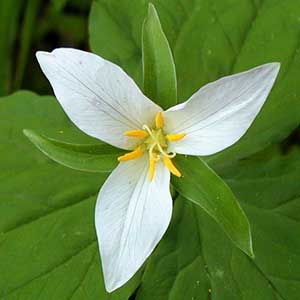Trillium ovatum
Trillium pusillum
Pacific trillium, trillium, western trillium, western wake-robin, western white trillium, white or western trillium, white trillium
dwarf trillium, dwarf wakerobin, least trillium, little trillium
semierect to horizontal, short, stout, praemorse.
horizontal, branching, thin.
1–2, round, 2–5 dm, ± slender, glabrous.
1–2, round in cross section, 0.7–2 dm, slender, becoming taller and more robust after flowering, glabrous.
sessile, subsessile, or short-petiolate;
blade medium green, sometimes blotched and mottled, main veins prominent, ovate-rhombic, 7–12 × 5–20 cm, continuing to expand during anthesis, base rounded, apex acuminate.
very short-petiolate, subsessile or sessile;
blade dark green with maroon undertones when young, not mottled, 3–5 major veins from base, oblong to lanceolate-obtuse, 2.5–8+ × 1–3 cm, not glossy, apex obtuse.
erect or nodding, odorless;
sepals spreading to horizontal, green, lanceolate to oblong-lanceolate, 15–50 × 6–20 mm, margins entire, apex acute;
petals erect-ascending, usually wide-spreading from base, exposing entire pistil, white or with pink or blush markings, lacking V-shaped markings, fading to rosy pink, purple, or dark red, veins not deeply engraved, ± linear to widely obovate, 1.5–7 ×1–4 cm, widest at or above middle, thin-textured, margins flat to undulate, apex acuminate;
stamens prominent, slightly recurved-spreading to straight, 10–18 mm;
filaments white, shorter than anthers, slender;
anthers yellow, 4–16 mm, slender, dehiscence latrorse-introrse;
ovary green or white, ovoid, 6-angled, 5–12 mm, attachment ± 3/4 ovary width;
stigmas recurved, barely connate basally, greenish white or white, linear, not lobed adaxially, 6–10 mm, uniformly thin;
pedicel erect to leaning, 2–6 cm.
above bracts, erect, odorless to faintly sweet, pedicellate or sessile;
sepals conspicuous, spreading to same plane as petals, dark green with maroon undertones when young, oblong-lanceolate, 15–30 × 5–10 mm, margins entire, apex obtuse to strongly rounded;
petals of short duration, spreading-ascending, exposing stamens and ovary, weakly recurved in distal 1/2, white, aging to deep rosy pink abaxially, veins not engraved but major petal veins clearly visible, oblong to narrowly lanceolate, 1.5–3 × 0.5–1.5 cm, thin-textured, widest above base, margins strongly undulate, quite variable in petal width and degree of undulation between individuals and populations, apex obtuse to weakly acute;
stamens erect-spreading, 8–10 mm;
filaments pinkish purple to white, ± equaling or slightly shorter than anthers, slender;
anthers ± straight, pale lavender or yellow, 3–8(–10) mm, thicker than filaments, dehiscence introrse;
connectives not extended beyond anther sacs;
ovary conspicuous, white, ovoid, obscurely 6-angled, 2.5–8 mm, attachment narrower than ovary;
stigmas confluent with style, greenish white to white, distally 3-lobed, lobes linear (threadlike), long-spreading, 3–12 mm, uniformly thin and threadlike;
pedicel stiffly erect to leaning, 0.5–2 cm, or absent to much reduced.
baccate, green or white, ± odorless, broadly ovoid, obscurely winged, 1.2–2.8 × 0.7–1.9 cm, pulpy-moist.
white or pale greenish, ovate, 1–1.5 cm, pulpy, moist but not juicy.
= 10.
= 10.
Trillium ovatum
Trillium pusillum
Varieties 2 (2 in the flora).
(Discussion copyrighted by Flora of North America; reprinted with permission.)
Varieties 2 (2 in the flora).
Trillium pusillum comprises widely disjunct, regional populations, each varying somewhat from the others and variable within itself as well. Some of these populations have been named as varieties or separate species. In the wild, the plants that have been recognized as var. ozarkanum generally grow taller than others and are said to have bracts with five major veins instead of three. Plants attributed to var. texanum, on the other hand, are generally smaller in all parts, with narrower petals, and often revert to a single bract when not flowering. Only var. virginianum is easily distinguished at sight by its “sessile” flower. This variety has received extensive study. P. R. Cabe (1995), in a morphological study including statistical analysis, found variation within and between populations. He felt that his results were inconclusive, and also that some of the variation might be environmentally induced. The variation that he found did not correlate with a geographic pattern, and he suggested treating all Virginia populations as var. virginianum, or simply T. pusillum. In a later study, P. R. Cabe and C. R. Werth (1995), using isozyme evidence, obtained like results, and suggested treating all Virginia populations as a single variety pending further investigation. Until there has been such study, of the Virginia plants as well as the rest of the T. pusillum complex, I choose to retain the fairly distinctive and more or less traditionally known var. virginianum, and include all other populations in a broadly circumscribed var. pusillum.
(Discussion copyrighted by Flora of North America; reprinted with permission.)
1. Bracts sessile; petals lanceolate to obovate, 1.5–7 × 1–4 cm | var. ovatum |
1. Bracts distinctly short-petiolate; petals linear to linear-lanceolate, 0.5–2.4 × 0.2–0.6 cm | var. oettingeri |
1. Flower pedicillate; pedicel usually 0.5–2 cm. | var. pusillum |
1. Flower sessile or subsessile; pedicel, if present, 0.1–0.3 cm | var. virginianum |
- Local floras:
BC,
CA,
OR,
WA
- Local Web sites:
CalFlora,
CalPhotos,
Flora NW,
PNW Herbaria,
Turner Photog.
WildflowerSearch
iNaturalist (observations)
USDA Plants Database
- LBJ Wildflower Center
- SEINet
- Plants of the World Online
- Encyclopedia of Life
- Wikipedia
- Google Image Search


